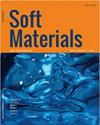Mononuclear photoluminescent salicylaldimato copper(II) complex: synthesis, characterization, mesomorphic investigation and DFT study
IF 1.4
4区 材料科学
Q4 MATERIALS SCIENCE, MULTIDISCIPLINARY
引用次数: 1
Abstract
ABSTRACT A new photoluminescent disc-like copper (II) metallomesogen of the type [CuL2] {H2L = 2,4-bis((E)-((4-(hexadecyloxy)phenyl)imino)methyl)phenol} have been synthesized. The compounds were characterized by elemental analyses, Fourier transform infrared spectroscopy (FTIR), 1H, 13C nuclear magnetic resonance (NMR), ultraviolet – visible spectroscopy (UV – Vis), thermogravimetric analysis (TGA) and high-resolution mass spectrometry. Mesomorphic behavior of the compounds was probed with the help of polarizing optical microscopy (POM) and differential scanning calorimetry (DSC). The organization of the molecules in the mesophase was investigated by X-ray diffraction techniques. The ligand is non-mesogenic but the copper complex exhibited thermally stable columnar mesophases at about 86°C. The copper complex is a blue-light emitter both in solution and in the solid state. The Density Functional Theory (DFT) study was carried out using 6–31 G (d, p) basis set with unrestricted B3LYP level to obtain a stable, optimized structure, which revealed a distorted square-planar geometry for the copper complexes.单核光致发光水杨醛铜(II)配合物:合成、表征、介形研究和DFT研究
合成了一种新的光致发光圆盘状铜(II)金属原[CuL2] {H2L = 2,4-双((E)-((4-(十六基氧基)苯基)亚氨基)甲基)苯酚}。通过元素分析、傅里叶红外光谱(FTIR)、1H、13C核磁共振(NMR)、紫外-可见光谱(UV - Vis)、热重分析(TGA)和高分辨率质谱对化合物进行了表征。利用偏光显微镜(POM)和差示扫描量热仪(DSC)研究了化合物的亚晶行为。用x射线衍射技术研究了中间相的分子结构。配体是非介生的,但铜配合物在约86℃时表现出热稳定的柱状介相。铜配合物在溶液和固体状态下都是蓝光发射器。利用密度泛函理论(DFT)研究了6-31 G (d, p)基集和不受限制的B3LYP水平,得到了稳定的优化结构,揭示了铜配合物的扭曲的方平面几何结构。
本文章由计算机程序翻译,如有差异,请以英文原文为准。
求助全文
约1分钟内获得全文
求助全文
来源期刊

Soft Materials
工程技术-材料科学:综合
CiteScore
2.90
自引率
0.00%
发文量
21
审稿时长
2.2 months
期刊介绍:
Providing a common forum for all soft matter scientists, Soft Materials covers theory, simulation, and experimental research in this rapidly expanding and interdisciplinary field. As soft materials are often at the heart of modern technologies, soft matter science has implications and applications in many areas ranging from biology to engineering.
Unlike many journals which focus primarily on individual classes of materials or particular applications, Soft Materials draw on all physical, chemical, materials science, and biological aspects of soft matter. Featured topics include polymers, biomacromolecules, colloids, membranes, Langmuir-Blodgett films, liquid crystals, granular matter, soft interfaces, complex fluids, surfactants, gels, nanomaterials, self-organization, supramolecular science, molecular recognition, soft glasses, amphiphiles, foams, and active matter.
Truly international in scope, Soft Materials contains original research, invited reviews, in-depth technical tutorials, and book reviews.
 求助内容:
求助内容: 应助结果提醒方式:
应助结果提醒方式:


